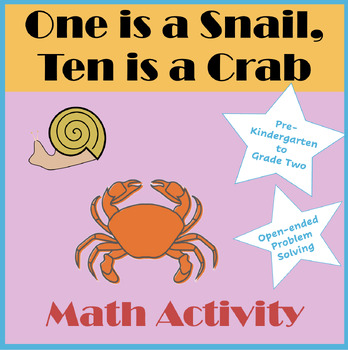One is a Snail, Ten is a Crab - Making Ten (Open-ended Math Problem Solving)
Ms Ts Teaching Treasures
84 Followers
Grade Levels
PreK - 2nd
Subjects
Resource Type
Standards
CCSSK.CC.A.3
CCSSK.OA.A.1
CCSSK.OA.A.2
CCSSK.OA.A.3
CCSSK.OA.A.4
Formats Included
- PDF
Ms Ts Teaching Treasures
84 Followers
Also included in
- Are you planning math centers? Use these resources to help students build numeracy skills when working with numbers in the range of zero to ten. Designed to develop fact fluency, this resource contains games, activities, and worksheets. All resources are fully prepped and ready to go - just hint priPrice $11.95Original Price $21.70Save $9.75
- Here are five ready-to-go lessons/activities to use after reading well-loved picture books. Students will deepen their mathematical understanding through the joy of story-telling. Using picture books to teach math deepens student engagement and allows them to see math in genuine real-world applicatiPrice $10.32Original Price $14.75Save $4.43
Description
This is a perfect open-ended math problem solving activity to pair with Jeffrey and April Sayre's beautiful book One is a Snail, Ten is a Crab. In this task, students cut and paste familiar animals from the book in order to make sets with ten legs in each. This activity is open-ended and differentiated to suit the needs of all learners.
Total Pages
Answer Key
Included
Teaching Duration
N/A
Report this resource to TPT
Reported resources will be reviewed by our team. Report this resource to let us know if this resource violates TPT’s content guidelines.
Standards
to see state-specific standards (only available in the US).
CCSSK.CC.A.3
Write numbers from 0 to 20. Represent a number of objects with a written numeral 0-20 (with 0 representing a count of no objects).
CCSSK.OA.A.1
Represent addition and subtraction with objects, fingers, mental images, drawings, sounds (e.g., claps), acting out situations, verbal explanations, expressions, or equations.
CCSSK.OA.A.2
Solve addition and subtraction word problems, and add and subtract within 10, e.g., by using objects or drawings to represent the problem.
CCSSK.OA.A.3
Decompose numbers less than or equal to 10 into pairs in more than one way, e.g., by using objects or drawings, and record each decomposition by a drawing or equation (e.g., 5 = 2 + 3 and 5 = 4 + 1).
CCSSK.OA.A.4
For any number from 1 to 9, find the number that makes 10 when added to the given number, e.g., by using objects or drawings, and record the answer with a drawing or equation.







